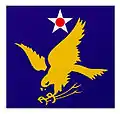834th Bombardment Squadron
The 834th Bombardment Squadron is an inactive United States Army Air Forces unit. It trained as a Consolidated B-24 Liberator unit, and deployed with its planes to the European Theater of Operations, entering combat in the strategic bombing campaign against Germany on 7 May 1944. In July 1944, the squadron converted to Boeing B-17 Flying Fortresses, continuing combat with the 486th Bombardment Group until April 1945. Following V-E Day it returned to Drew Field, Florida, where it was inactivated on 7 November 1945.
| 834th Bombardment Squadron | |
|---|---|
 486th Bombardment Group B-17 Flying Fortresses | |
| Active | 1943–1945 |
| Country | |
| Branch | |
| Role | heavy bomber |
| Nickname(s) | Zodiac Squadron |
| Engagements | European Theater of Operations |
| Insignia | |
| 834th Bombardment Squadron emblem[1] |  |
History
The 834th Bombardment Squadron was activated at McCook Army Air Field, Nebraska on 20 September 1943 as one of the original squadrons of the 486th Bombardment Group. After organizing as a Consolidated B-24 Liberator unit, it moved to Davis-Monthan Field, Arizona in November and trained for combat. The squadron began deploying overseas in early March 1944.[2][3] Its air echelon flew its Liberators along the southern ferry route.[4]
The squadron arrived at its combat station, RAF Sudbury, the following month. The squadron became known as the "Zodiac Squadron" from the pictures of the zodiac figures painted on their noses. A commercial artist named Phil Brinkman, from Chicago, was responsible for the pin-up nose art of the B-24 Liberators.[5] It flew its first combat mission on May 7.[4] It conducted strategic bombing missions against industrial facilities, including oil refineries and petroleum storage facilities at Dollbergen, Hamburg and Merseburg and factories at Mannheim and Weimar. It also struck at transportation targets, such as marshalling yards near Köln, Mainz and Stuttgart; airfields at Kassel and Münster; and harbor installations at Bremen and Kiel.[3] On 19 July 1944, along with the other B-24 units of the 92d Bombardment Wing, the squadron was taken off operations and began conversion to the Boeing B-17 Flying Fortress. This would mark the beginning of the change of the 3d Bombardment Division to an All-B-17 unit. The group completed its conversion and resumed operations by 1 August, while its Liberators were sent to depots in England for eventual transfer as replacements to 2d Bombardment Division groups.[4][6]

The squadron was occasionally diverted from strategic targets to support ground forces. Preparing for Operation Overlord, the invasion of Normandy, it attacked bridges, V-weapons launch sites, and airfields. On D-Day it bombed gun positions. As Allied forces advanced across northern France in the summer of 1944, it attacked troop concentrations and road junctions. During Operation Market Garden, it struck gun positions near Arnhem to minimize losses among glider and paratroopers attempting to seize bridges across the Rhine River. In December 1944 and January 1945 it supported troops fighting the Battle of the Bulge. In the spring of 1945 it supported Operation Varsity, the airborne assault across the Rhine.[3] The squadron flew its last mission on 21 April 1945.[4]
The squadron remained in England until August 1945, when it returned to the United States. Its aircraft began departing in early July, while its ground echelon sailed on the RMS Queen Elizabeth on 25 August, arriving in New York City six days later.[4] The 834th reassembled at Drew Field, Florida in September, but was inactivated there on 7 November 1945.[2]
Lineage
- Constituted as the 834th Bombardment Squadron (Heavy) on 14 September 1943
- Activated on 20 September 1943
- Redesignated 834th Bombardment Squadron, Heavy c. 1944
- Inactivated on 7 November 1945[2]
Assignments
- 486th Bombardment Group, 20 September 1943 – 7 November 1945[2]
Stations
Aircraft
- Consolidated B-24H Liberator, 1943–1944
- Boeing B-17G Flying Fortress, 1944–1945[2]
Campaigns
| Campaign Streamer | Campaign | Dates | Notes |
|---|---|---|---|
| Air Offensive, Europe | 5 April 1944–5 June 1944 | [2] | |
| Air Combat, EAME Theater | 5 April 1944–11 May 1945 | [2] | |
| Normandy | 6 June 1944–24 July 1944 | [2] | |
| Northern France | 25 July 1944–14 September 1944 | [2] | |
| Rhineland | 15 September 1944–21 March 1945 | [2] | |
| Ardennes-Alsace | 16 December 1944–25 January 1945 | [2] | |
| Central Europe | 22 March 1944–21 May 1945 | [2] |
See also
References
Notes
- Watkins, p. 110
- Maurer, Combat Squadrons, pp. 774-775
- Maurer, Combat Units, p. 357
- Freeman, p. 260
- Valant, pp. 13-15.
- Freeman, p. 172
- Station number in Anderson, p. 22.
- Station information in Maurer, Combat Squadrons, pp. 774-775, except as noted.
Bibliography
![]() This article incorporates public domain material from the Air Force Historical Research Agency website http://www.afhra.af.mil/.
This article incorporates public domain material from the Air Force Historical Research Agency website http://www.afhra.af.mil/.
- Anderson, Capt. Barry (1985). Army Air Forces Stations: A Guide to the Stations Where U.S. Army Air Forces Personnel Served in the United Kingdom During World War II (PDF). Maxwell AFB, AL yes: Research Division, USAF Historical Research Center. Archived from the original (PDF) on 23 January 2016. Retrieved 28 June 2017.
- Freeman, Roger A. (1970). The Mighty Eighth: Units, Men and Machines (A History of the US 8th Army Air Force). London, England, UK: Macdonald and Company. ISBN 978-0-87938-638-2.
- Maurer, Maurer, ed. (1983) [1961]. Air Force Combat Units of World War II (PDF) (reprint ed.). Washington, DC: Office of Air Force History. ISBN 0-912799-02-1. LCCN 61060979. Retrieved 17 December 2016.
- Maurer, Maurer, ed. (1982) [1969]. Combat Squadrons of the Air Force, World War II (PDF) (reprint ed.). Washington, DC: Office of Air Force History. ISBN 0-405-12194-6. LCCN 70605402. OCLC 72556.
- Valant, Gary M. (1997). Classic Vintage Nose Art. Ann Arbor, MI: Lowe and B. Hould, an imprint of Borders, Inc. ISBN 0-681-22744-3.}
